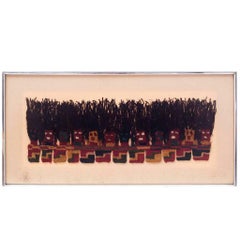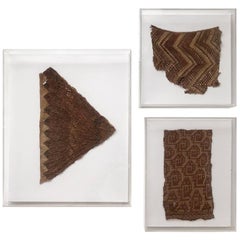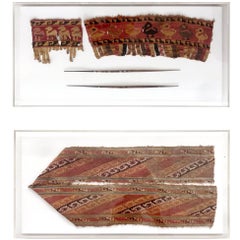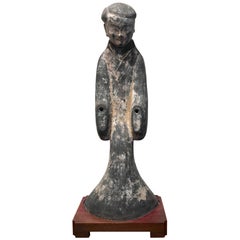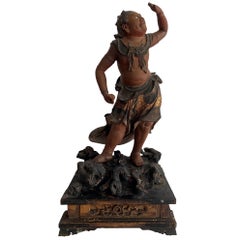TISHU Furniture
to
3
155
155
1
155
337
638
108
171
209
188
26
4
14
18
32
49
46
68
35
30
99
37
19
12
12
132
115
54
33
28
155
155
155
1
Period: 18th Century and Earlier
Framed Pre-Columbian Proto Nazca Textile Frangment
Located in Atlanta, GA
A Proto-Nazca textile fragment from Southern Peru circa 100BC-200AD. The linked munecas ("dolls" in Spanish) figures were woven with fibers likely from l...
Category
Antique 15th Century and Earlier Peruvian Pre-Columbian Tapestries
Materials
Wool
Group of Three Framed Pre-Columbian Textile Fragments
Located in Atlanta, GA
Three textile fragment framed in Lucite shadow boxes, from pre-Columbian Peru, likely Chancay Culture in the central coastal region circa 14-15th century. With different weaving tech...
Category
Antique 15th Century and Earlier Peruvian Pre-Columbian Shadow Boxes
Materials
Wool, Natural Fiber
Two Framed Pre-Columbian Textile and Tools
Located in Atlanta, GA
Two antique textile fragments and two painted textile tools spindle needle framed in a pair matching Lucite shadow boxes. The textiles were li...
Category
Antique 15th Century and Earlier Peruvian Pre-Columbian Shadow Boxes
Materials
Wool, Alpaca, Wood
Tomb Lady in Waiting Figurine Han Dynasty
Located in Atlanta, GA
On offer is a pottery figurine of lady in waiting, found in the tombs as funeral objects in Han dynasty of China. Generally known as Han tomb ladies, t...
Category
Antique 15th Century and Earlier Chinese Han Ceramics
Materials
Pottery
Japanese Lacquered and Gilt Wood Buddhism Statue from Edo Period
Located in Atlanta, GA
An exceptional and wood statue of Buddhism Guardian Seitaka Doji from Japan circa Edo period (1603-1868), likely the earlier part of 17th century. One of two chief attendants of Fudou Myouou (the other being Kongara Doji), the name of Seitaka Doji is a transliteration of Sanskrit "Cetaka", meaning servant, slave, and he is said to personify expedient action. He is most commonly found on the right side of Fudou, together with Kongara Doji on the left, forming the Immovable triad, Fudou Sanzon, the terror of evil doers. Seitaka largely adheres to the iconography of a wrathful youth with fleshy body and face, skin in the color of a red lotus, has his hair tied in five knots, and holds a vajra in his left hand and a vajra-club in his right hand, but the actual artistic representations of him in Japan do...
Category
Antique 17th Century Japanese Japonisme Sculptures and Carvings
Materials
Metal
Antique Chinese Ceramic Tea Leaf Storage Jar Song-Yuan Dynasty
Located in Atlanta, GA
A stoneware pottery jar used for storage, made in southern China Fujian or Guangdong province since Song Dynasty for domestic use as well as export. They were widely exported to Japa...
Category
Antique 15th Century and Earlier Chinese Archaistic Ceramics
Materials
Ceramic
Antique Japanese Hanging Scroll Attributed to Iwasa Matabei
Located in Atlanta, GA
An antique ink and color on paper hanging scroll (kakejiku) with brocade border. It appears to be a fragment of a larger hand scroll depicting a procession of a lord with his entoura...
Category
Antique Early 17th Century Japanese Japonisme Paintings and Screens
Materials
Silk, Paper
Large Antique Zen Japanese Ink Scroll After Sesson Shukei
Located in Atlanta, GA
A Japanese Sumi ink painting with light color wash mounted with brocade borders as a hanging scroll (Kakejiku). The painting depicts the famously eccentric Buddhist monks Hanshan and Shide (known in Japan as Kanzan and Jittoku). Often as a pair, they have been a popular motif in Japanese Zen painting...
Category
Antique 18th Century Japanese Japonisme Paintings and Screens
Materials
Silk, Paper
Antique Thai Celadon Stemmed Dish Sukhothai Sawankhalok
Located in Atlanta, GA
A celadon stemmed dish with underglaze deep blue decoration from Sukhothai (a former Kingdom in nowadays central Thailand) circa 14th-16th century. The pedestal dish was a typical ceramic output from Sawankhalok region, likely one of the kilns in Sri Sachanalai that thrived during 14th-15th century. Sukhothai ceramics made a large portion of export from Asia during that period due to the political policy in Ming Dynasty that banned the ocean faring (the so called Ming Gap). This stemmed dish, likely an export item, was modeled in a Classic Chinese form. The under-glaze deep blue decorations depicting the scrolling vines and flowers, as well as the archaic band around the base, are also reminiscent to the designs found in blue and white porcelain in Ming dynasty. The piece shows a fine crackles and age wear on the dish surface, an indication of appropriate patina. Under the reddish slip paint of the base, the gray paste can be discerned in small area, which is also a characteristic of the Thai celadon...
Category
Antique 15th Century and Earlier Thai Archaistic Ceramics
Materials
Ceramic
Japanese Ceramic Sake Bottle Chosen Karatsu Ware
Located in Atlanta, GA
The long neck bottle of classic form was heavily potted with coarse clay with high iron content. The flask, circa 18th century Edo period, was purposed for sake storage but also substituted as a flower vase during tea ceremony. The surface is covered in glossy black glaze and contrasts strikingly with white ash glaze around the shoulder. The white, fired with straw, displays a splashing feather effect and fine crackles, blending in with the black artistically. This type of Karatsu ware...
Category
Antique 18th Century Japanese Japonisme Ceramics
Materials
Ceramic
Antique Japanese Iron Stirrups with Silver Inlay Signed
Located in Atlanta, GA
A pair of antique Japanese Abumis, stirrup for horse-riding, in cast iron with elaborate silver inlay, circa 16th century Muramachi to Momoyama period. The prototype of Japanese abum...
Category
Antique 16th Century Japanese Japonisme Metalwork
Materials
Silver, Iron
Han Dynasty Horse and Rider TL Tested
Located in Atlanta, GA
Tombs of the Han dynasty (206 BC-220 AD) were typically furnished with model figures and other objects believed to be necessary for a safe journey to the afterlife. Historical records indicate that when important military officials died, the imperial Han court would give them elaborate funerals, including a full military cortege. It is likely that this figure of a horse and rider was originally part of a model funerary retinue comprised of soldiers and cavalrymen that would have been placed in such a tomb.
Beautifully proportioned Han dynasty polychrome painted terracotta horse and rider. The warrior is decorated with a painted orange and black tunic. A quiver is visible attached to his back. He would have originally held a wooden bow in between his hands that has rotted away over the centuries. He is riding a beautifully sculpted white horse.
TL tested...
Category
Antique 15th Century and Earlier Chinese Antiquities
Materials
Earthenware, Pottery
Chinese Huanghuali Brush Pot
Located in Atlanta, GA
Chinese Huanghuali brush pot
18th century
Carved cylindrical Chinese scholar’s brush pot, composed from the extincted Huanghuali wood. Beautifu...
Category
Antique 18th Century Chinese Qing Scholar's Objects
Materials
Wood
Chinese Ceramic Glazed Guardian Ming Dynasty
Located in Atlanta, GA
A stoneware figure depicting a seated armored warrior with a striking pose circa 15th-17th century. He is likely one of the four heavenly kings, th...
Category
Antique 16th Century Chinese Ming Ceramics
Materials
Stoneware
Chinese Stoneware Funeral Shrine Model and Figure Ming Dynasty
Located in Atlanta, GA
A stoneware shrine model with a figurine made in Ming dynasty (15th-17th century) in China and used as funeral burial objects. It is not known whether the two objects were originally associated, but they display similar glaze and oxidation and were in the same collection. The stoneware building is an architectural rendering of a typical ancestor shrine used at the time. It features a single room behind an elaborate front with double doors, under a multiple layered eaves. There are great architectural and decorative details throughout. The green glaze shows a wonderful silvery oxidation, an indication that the piece was buried in the ground. The side appears to be glazed lightly originally and some scrape marks and oxidized glaze residues remains. The back is unglazed. The figure is a typical tomb figurine...
Category
Antique 16th Century Chinese Ming Ceramics
Materials
Stoneware
Stoneware Storage Jar China East Zhou Dynasty
Located in Atlanta, GA
A pinkish stoneware jar with broad shoulder and slightly tapered body from Chinese East Zhou Dynasty (771-256BC). The surface of the jar was nearly thorou...
Category
Antique 15th Century and Earlier Chinese Archaistic Ceramics
Materials
Stoneware
Chinese Terracotta Tomb Figure East Han Dynasty
Located in Atlanta, GA
A small Chinese terracotta tomb figure (Ni Yong) from East Han dynasty (25-220 AD), likely from the area of nowadays Sichuan. It depicts a sitting male wit...
Category
Antique 15th Century and Earlier Chinese Han Ceramics
Materials
Terracotta
Dvaravati Stucco Buddha Head from Thailand
Located in Atlanta, GA
On offer is an early Buddha image from Dvaravati period (6-11th century) in Central Thailand. Made of stucco with an unfinished back suggesting its original use in architectural cont...
Category
Antique 15th Century and Earlier Thai Archaistic Antiquities
Materials
Stucco, Wood
Antique Southeast Asian Ceramic Fish Bowl Thailand Sukhothai Period
Located in Atlanta, GA
A shallow ceramic bowl from Sukhothai period of Thailand circa 14th-15th century. The dish was hand molded with a coarse pinkish clay and it has a...
Category
Antique 15th Century and Earlier Thai Archaistic Ceramics
Materials
Ceramic
Fine Chinese Stucco Head of Bodhisattva Southern Dynasties
Located in Atlanta, GA
On offer is a fine Bodhisattva head made of stucco around a wood core circa 6th century AD. The fragment was part of high-relief wall sculpture based ...
Category
Antique 15th Century and Earlier Chinese Archaistic Sculptures and Carvings
Materials
Earthenware, Stucco, Petrified Wood
Pair of Japanese Ink Hanging Scrolls Kano Tanyu
By Kano Tan'yu 1
Located in Atlanta, GA
A fine matching pair of hanging scrolls ink on paper mounted in green brocade borders circa Edo period (17-18th century). The Kano school painting depicts wild geese in the reeds by the margin of water, a popular subject borrowed from the Chinese tradition. Both painting were signed as Tanyu with a red seal of Morinobu, his birth name. The storage box is also present and was inscribed with the title Painting of Geese and Reeds and Kano Tanyu...
Category
Antique Late 17th Century Japanese Japonisme Paintings and Screens
Materials
Wood, Paper
Antique Japanese Inro by Shigehide Edo Period
Located in Atlanta, GA
This exquisite four-case lacquered inro was dated to the latter part of 18th century to early 19th century (Edo period) and made by Shigehide. The opposite sides of the inro together features a lavish flower arrangement in a bamboo basket (ikebana). The detailed craftmanship was a true pleasure to behold. Mostly Takamaki-e (high relief) were used to texturize the delicate petals of the chrysanthemums, on which different shades of gold were used to create contrast. Raden (mother of pearl) shells were also used to highlight some leaves, rendering the piece an interesting balance of color and material. The interior was completed in a mottled gold finish. It was signed Shigehide on the bottom with a Kao. There is a small carved rabbit ojime bead...
Category
Antique Late 18th Century Japanese Japonisme Lacquer
Materials
Wood, Lacquer
Antique Lopburi Buddha Statue from Thailand
Located in Atlanta, GA
The Buddha statue was made from a copper alloy in a standing position with hands in double Abhaya mudra. This mudra symbolizes the act of dispelling fear in the face of adversity. In Laos and Thailand where this mudra are used as one of the most iconic gestures, with its origin was pre-Buddhism era, when it was a symbol of good intentions and friendship when approaching strangers. In contrast to Indian iconography, it was often shown with both hands raised to the level of the shoulder in Southeast Asia. The statue was made in the classic Lopburi style, which historically was heavily influenced by Khmer art...
Category
Antique Late 18th Century Thai Other Sculptures and Carvings
Materials
Metal
Antique Brocade Kesa Monk's Patched Robe Edo Period
Located in Atlanta, GA
Kesa, known as "Jiasha" in Chinese and "Kasaya" in Sanskrit, is an out layer garment worn by the ordained Buddhist monks. Bearing a basic rectangular form, it developed originally in...
Category
Antique Late 18th Century Japanese Edo Textiles
Materials
Textile, Brocade
Collection of Three Chinese Neolithic Pottery
Located in Atlanta, GA
A collection of three small Chinese Neolithic pottery jars consisting a red slender jar with large double ears, a grey and wide short jar wit...
Category
Antique 15th Century and Earlier Chinese Archaistic Ceramics
Materials
Ceramic
Korean Ceramic Celadon Bowl with Slip Inlay Goryeo Dynasty
Located in Atlanta, GA
Despite inspired originally by the celadons from Song Dynasty in China, the development of celadon in Korean peninsula took its own course and reached the Zenith in the 11-12th century during Goryeo dynasty...
Category
Antique 15th Century and Earlier Korean Archaistic Ceramics
Materials
Ceramic
Korean Ceramic Celadon Bowl with Slip Inlay Goryeo Dynasty
Located in Atlanta, GA
Despite inspired originally by the celadons from Song dynasty in China, the development of celadon in Korean peninsula took its own course and reached the zenith in the 11-12th century during Goryeo dynasty...
Category
Antique 15th Century and Earlier Ceramics
Materials
Ceramic
Celadon Ceramic Tea Bowl Korean Goryeo Dynasty
Located in Atlanta, GA
An antique Korean ceramic tea bowl with celadon glaze from Goryeo dynasty, circa 12th century. The thin-walled stoneware bowl was potted delicately with...
Category
Antique 15th Century and Earlier Korean Archaistic Ceramics
Materials
Ceramic
Korean Celadon Inlay Vase Goryeo Dynasty
Located in Atlanta, GA
On offer is an antique Korean ceramic vase from the end of Goryeo to the beginning of Joseon period (circa 14-15th). The vase features celadon crackled glaze with underglaze inlay design in black and white. The vase was a transitional piece made toward the end of Goryeo to the beginning of Joseon Yi dynasty...
Category
Antique 15th Century and Earlier Korean Archaistic Ceramics
Materials
Ceramic
Korean Celadon Inlay Plate Goryeo Period
Located in Atlanta, GA
The round ceramic plate with a slightly raised foot ring is dated from late Korean Goryeo Kingdom (918 to 1392 AD) likely toward the end of the 14th century. The plate features a celadon glaze and underglaze slip inlays in black and white. The inlays showcases a pair of bird (appears to be cranes) in the center of a radiating double walled ring...
Category
Antique 15th Century and Earlier Korean Archaistic Ceramics
Materials
Ceramic
Korean Ceramic Celadon Deep Bowl Goryeo Dynasty
Located in Atlanta, GA
A ceramic bowl with celadon glaze from Korea, circa 14th century (late Goryeo Dynasty). The particular shape of the bowl suggests that it is likely a "Bo" (Chinese) or "Hattara" (Japanese "Oryoki"). This is a Buddhism term derived from Sanskrit word "patra", which means "vessel that contains just enough". The container was used traditionally by Buddhist monks to ask for alms (donated foods by laymen). The deep volume and the wide opening are conducive to its utility function. The bowl is covered in a jade-color celadon which has very fine and uniform crackles throughout. Upon close inspection of the exterior wall, one can detect a very light brush of white slip circumventing the body. The white slip brushing technique only became popular from 15th century on as a landmark of the Buncheong ceramics...
Category
Antique 15th Century and Earlier Korean Archaistic Ceramics
Materials
Ceramic
Antique Korean Ceramic Bowl with Incised Design
Located in Atlanta, GA
A Korean stoneware bowl from Goryeo dynasty circa 12th century. The conical form bowl with a small raised foot rim is covered in a celadon green glaze...
Category
Antique 15th Century and Earlier Korean Archaistic Ceramics
Materials
Ceramic
Ceramic Bowl Buncheong Ware Joseon Dynasty
Located in Atlanta, GA
A Buncheong (also spelled as Punch'ong) stoneware tea bowl from Korea Joseon Dynasty circa 15-16th century. The conical shape bowl in the classical styl...
Category
Antique 16th Century Korean Archaistic Ceramics
Materials
Ceramic
Korean Ceramic Celadon Bowl with Slip Inlay Goryeo Dynasty
Located in Atlanta, GA
The celadon bowl on offer here was likely dated to the 14th century toward the end of Goryeo Dynasty, after the production quality reached its zenith during 11-12th century. The bowl...
Category
Antique 15th Century and Earlier Korean Archaistic Ceramics
Materials
Ceramic
Korean Ceramic Celadon Bowl with Slip Inlay Goryeo Dynasty
Located in Atlanta, GA
A good Korean celadon bowl with elaborate slip inlays circa 12-13th century from the Goryeo Dynasties (918 to 1392AD). Despite inspired originally ...
Category
Antique 15th Century and Earlier Korean Archaistic Ceramics
Materials
Ceramic
Korean Ceramic Tea Bowl with Slip Inlays Goryeo Dynasty
Located in Atlanta, GA
A small ceramic conical form tea bowl from Korean Goryeo Dynasty circa 14th century. The bowl is of a slightly irregular shape and covered in a grayish overglaze. The inlaid slip dec...
Category
Antique 15th Century and Earlier Korean Archaistic Ceramics
Materials
Ceramic
Antique Korean Ceramic Bowl with Carved Design Goryeo Dynasty
Located in Atlanta, GA
A Korean stoneware bowl from Goryeo dynasty circa 12th century. The conical form bowl with a small raised foot rim is covered in a celadon green glaze. ...
Category
Antique 15th Century and Earlier Korean Archaistic Ceramics
Materials
Ceramic
Korean Ceramic Ritual Offering Vessel with Inscription Joseon Dynasty
Located in Atlanta, GA
A ceramic dish with high cylindrical foot in white glaze with a cobalt blue underglaze inscription from Korea, circa 18-19th century Joseon Dynasty. This is a classic ceremonial vess...
Category
Antique Late 18th Century Korean Archaistic Ceramics
Materials
Ceramic
Korean Ceramic Ritual Offering Stemmed Dish with Inscription Joseon Dynasty
Located in Atlanta, GA
A small ceramic stemmed dish with high cylindrical foot in white glaze with a cobalt blue underglaze inscription in the center from Korea, circa 18-19th cent...
Category
Antique Late 18th Century Korean Archaistic Ceramics
Materials
Ceramic
Antique Japanese Lacquered Incense Box Kobako Ex-Christie's
Located in Atlanta, GA
An old Japanese lacquered small box likely used to contain incense powder called Kobako, circa Momoyama to early Edo period (16-17th century). The rectangular form box with a fitted ...
Category
Antique 17th Century Japanese Japonisme Lacquer
Materials
Lead
Indian Terracotta Sculpted Head Gupta Period
Located in Atlanta, GA
A fragment of Terracotta statue displayed on wood block stand from ancient Indian continent dated to the Gupta period (4th-6th century). The head of the...
Category
Antique 15th Century and Earlier Indian Archaistic Sculptures and Carvings
Materials
Terracotta, Wood
Chinese Terracotta Statue Tomb Figure East Han Dynasty
Located in Atlanta, GA
A Chinese terracotta tomb figure (Ni Yong) from East Han Dynasty (25-220 AD), likely from the area of nowadays Sichuan. It depicts a horse groomer with tool and harness in hand. Dres...
Category
Antique 15th Century and Earlier Chinese Archaistic Sculptures and Carvings
Materials
Clay
Small Korean Stoneware Bungcheong Bowl Joseon Dynasty
Located in Atlanta, GA
A small Korean ceramic shallow bowl on ringed foot in the classic Buncheong (or Punch'ong) style from Joseon Dynasty circa 15-16th century. Originally intended for wine-drinking like...
Category
Antique 16th Century Korean Archaistic Ceramics
Materials
Ceramic
Antique Korean Ceramic White Bowl Joseon Dynasty
Located in Atlanta, GA
A Korean ceramic bowl covered in a white glaze with a hint of bluish green circa 18th century, possibly earlier of the Joseon Dynasty. The deep bowl fea...
Category
Antique 18th Century Korean Archaistic Ceramics
Materials
Ceramic
Antique Korean Buncheong Ceramic Vase with Incised Designs
Located in Atlanta, GA
A Korean ceramic bottle form jar of Buncheong ware circa 15-16th century Joseon Dynasty. The surface of the jar features a celadon glaze and an elaborate incised design of large flor...
Category
Antique 16th Century Korean Archaistic Ceramics
Materials
Ceramic
Antique Korean Celadon Bottle Vase Joseon Dynasty
Located in Atlanta, GA
A Korean ceramic bottle-form vase circa 16th century Joseon Dynasty. It was likely intended as a wine bottle, the pear-shaped vessel with flaring neck feature a celadon glaze exterio...
Category
Antique 16th Century Korean Archaistic Ceramics
Materials
Ceramic
Antique Islamic Glazed Ceramic Bowl with Splashed Decoration
Located in Atlanta, GA
An Islamic ceramic bowl from Samanid Dynasty Persia circa 10th century, possibly from Nishapur. The earth ware body of the bowl was made of a red clay, whic...
Category
Antique 15th Century and Earlier Persian Islamic Ceramics
Materials
Ceramic
Antique Islamic Ceramic Glazed Bowl with Splashed and Sgraffito Decoration
Located in Atlanta, GA
A small Islamic ceramic bowl circa 11-12th century, possibly from Nishapur or Aghkand area of Persia. The elegantly shaped bowl with a slightly flared opening is supported on a small foot rim. The earth ware...
Category
Antique 15th Century and Earlier Persian Islamic Ceramics
Materials
Ceramic
Pair Antique Japanese Artia Ceramic Cabinet Plates
By Arita
Located in Atlanta, GA
A pair of Japanese decorative ceramic plates, made in Arita for export market circa 17-18th century. The cabinet-display dishes feature lotus-petal gilt rim and a lavish tricolor ene...
Category
Antique 18th Century Japanese Japonisme Ceramics
Materials
Ceramic
Fine Korean Pottery Footed Jar with Long Neck Silla Period
Located in Atlanta, GA
A stoneware jar of bulbous form with a long neck supported by open-work foot dated from Silla, Three Kingdoms period (57 BCE-668 AD). The grey color ves...
Category
Antique 15th Century and Earlier Korean Archaistic Ceramics
Materials
Ceramic
Collection of Three Framed Coptic Textile Fragments
Located in Atlanta, GA
A collection of three antique textile fragments displayed in various frames from an estate collection in US. It consists of a blue on white woven panel presented in a metal frame. Th...
Category
Antique 15th Century and Earlier European Archaistic Tapestries
Materials
Textile, Wood
Two Framed Pre-Columbian Textile Fragment Chancay Culture Peru
Located in Atlanta, GA
Two framed pre-Columbian textile fragments from Chancay culture (1000AD-1470AD) in nowadays Peru. Both panels are of a similar red background and possibly wove...
Category
Antique 15th Century and Earlier Peruvian Pre-Columbian Tapestries
Materials
Textile, Wood
Two Framed Pre-Columbian Textile Fragments Inca Culture Peru
Located in Atlanta, GA
Two pre-Columbian textile fragments presented in wood frames. Handwoven in colored yarn, possibly camelid fibers, these pieces were from Inca period circa 15-16th century. One panel is a classic Inca weave that was likely part of a mantle or cape. It has a multi-panel design with eight-point stars alternating with stylized animal and homomorphic figures, steps-design and abstract scrolling patterns. The second one features a multiple stripe design also with eight-point star and a mysterious figure sandwiched between stripes of geometrical patterns and plain borders. Presenting in a thin gilt wood and a carved dark wood frame...
Category
Antique 15th Century and Earlier Peruvian Pre-Columbian Tapestries
Materials
Textile, Wood
Framed Pre-Columbian Textile Fragment
Located in Atlanta, GA
A nicely framed fragment of antique Pre-Columbian textile that depicts a stylized figure in a geometrical background. Linen backing. The original is l...
Category
Antique 15th Century and Earlier Peruvian Pre-Columbian Decorative Art
Materials
Cotton
Large Framed Pre-Columbian Antique Peruvian Textile Fragment Chancay Culture
Located in Atlanta, GA
A fragment of antique Peruvian textile from Pre-Columbia era, nicely displayed in a matted metal frame. Likely from Chancay culture in Centra...
Category
Antique 16th Century Peruvian Pre-Columbian Quilts and Blankets
Materials
Cotton, Linen
Two Framed Pre-Columbian Textile Fragments Nazca Culture
Located in Atlanta, GA
Two small fragments of pre-Columbian textiles in shadow box frames. Both have strong geometrical patterns in the style of Nazca culture, located in the southern coast of nowadays Per...
Category
Antique 15th Century and Earlier South American Pre-Columbian Tapestries
Materials
Wool
Korean Bronze Bottle Goryeo Dynasty
Located in Atlanta, GA
An antique Korean bronze bottle of bulbous pear form with a long neck and flared open mouth from Goryeo Dynasty (918 AD-1392 AD) circa 12-13th century I...
Category
Antique 15th Century and Earlier Korean Archaistic Bottles
Materials
Bronze
Two Islamic Nishapur Glazed Pottery Bowls
Located in Atlanta, GA
A collection of two small pottery bowls with polychrome central figurative decorations, matching size and similar conical form. These bowls are identified as Nishapur ware circa 10th century (in nowadays Iran). They were stoneware (possibly buffware) and covered with opaque white glaze. Both were lovely decorated with a central human figure within an outer border. One is predominantly yellow, an imitation of luster ware...
Category
Antique 15th Century and Earlier Persian Islamic Ceramics
Materials
Ceramic
Korean Caledon Vase Bottle with Kintsugi Repair Goryeo Dynasty
Located in Atlanta, GA
A ceramic wide-mouthed bottle vase covered in green celadon glaze from Goryeo dynasty circa 11-12th century. The bottle vase with such a form (mouth with wide rim, long and slender neck, tall body with swelled shoulders that taper down toward the base) is known as "kwanggubyong" in Korean and developed from the prototype of bottles from united Silla kingdom. It was used for holding oil or liquid. Some of this type of vase take a plain form without much decoration other than glaze; Some feature basic geometrical lines, such as this one. Three concentric rings were featured along the neck and on the shoulder. Some with more carving on the body (see a vase in the collection of Brooklyn Musuem, 79.246.3) or a simple paint with iron glaze (See c.16-1930 in Fitzwilliam Musuem, Cambridge, UK).
The vase on offer is covered in a lovely green celadon glaze which exhibits fine even crackles throughout the surface. It has a slightly uneven base with the foot ring shaved by the potter. The surface is original with a nice mellow patina. There is a historical kintsugi repair on the mouth rim, with its gold vain...
Category
Antique 15th Century and Earlier Korean Archaistic Ceramics
Materials
Ceramic
Large Tang Dynasty Prancing Horse with Oxford TL Test
Located in Atlanta, GA
This spirited Tang Dynasty (618–907 AD) prancing horse is handsomely model with one foreleg raised, it’s mane swept to one side, expressive pricked ears, flared nostrils and open mouth bearing its teeth. The tail is docked tail and is neatly tied. This terracotta horse has traces of painted pigmentation that once adorned it.
After their Han ancestors, the emperors of the Tang Dynasty continued to import purebred horses. Most of them served in wars but the most handsome were kept and trained for parades. We know that the Emperor Xuanzong (712-756) had a stud farm with 400 horses trained to dance to music. This prancing horse is a representation of the dancing horses of the Tang dynasty.
The Oxford TL test...
Category
Antique 15th Century and Earlier Chinese Sculptures and Carvings
Materials
Ceramic, Terracotta
